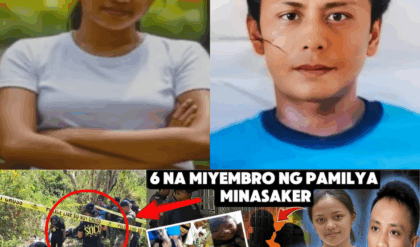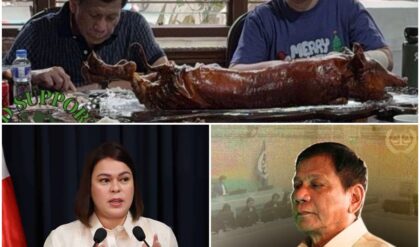Buried Secrets Beneath the Cockpit: The Chilling Mystery of the Missing Sabungeros and the Nation’s Cry for Justice
In a story that has shaken the Philippines to its core, new revelations have surfaced surrounding the mysterious disappearance of several “sabongeros” — men involved in the country’s once-flourishing cockfighting industry. What began as isolated missing-person reports has turned into one of the most haunting criminal investigations in recent memory, as authorities uncover the possibility that these men were buried underground to conceal evidence.
The case, already mired in controversy, has reignited a national conversation about corruption, power, and the price of silence in a society where underground gambling and organized crime often intersect. As forensic teams work tirelessly to identify remains that don’t match any DNA records, one question looms over the nation: how deep does this conspiracy go?

A String of Disappearances That Refused to Fade
It started like many tragedies — quietly. Between late 2021 and mid-2022, families from across Luzon began reporting their loved ones missing. The men shared a common thread: they were sabongeros — handlers, breeders, and bettors connected to the online cockfighting scene, an industry that had boomed during the pandemic before the government officially shut it down.
At first, the cases seemed unrelated. Police reports listed them as ordinary missing-person cases. But as numbers grew, the pattern became impossible to ignore. Dozens of men vanished under similar circumstances — attending scheduled cockfights, meeting contacts at remote venues, then never coming home.
Desperate families took to social media, sharing photos, begging for information, and organizing search groups. Their cries reached national attention when one mother’s tearful plea during a live television broadcast asked, “Where are our sons? Are they still alive?”
Authorities Step In — Too Late, Too Slowly
By the time the Philippine National Police (PNP) formed a task force to investigate, months had passed. Leads were cold. Witnesses were hesitant to speak. Insiders whispered about gambling debts, powerful backers, and payoffs to silence those who knew too much.
A few suspects were detained, including individuals linked to private security firms and cockfighting operations. Yet, no solid case held up in court. Evidence was scarce, and the deeper investigators dug, the more they found themselves facing walls of fear and influence.
The families accused law enforcement of dragging their feet — or worse, of protecting high-profile personalities allegedly connected to the lucrative e-sabong network. One relative told ABS-CBN: “It feels like justice is being buried with them. Every day that passes is another shovel of dirt on the truth.”
The Shocking Turn: Unearthing the Underground
Then, everything changed. In a remote area on the outskirts of Bulacan, workers stumbled upon what appeared to be a hidden burial site. Inside were human remains — multiple bodies in varying stages of decomposition. The discovery reignited public outrage and reopened every dormant investigation tied to the sabongeros.
Forensic experts were immediately called in. DNA samples were collected from the families of the missing, but to their horror, none of the results matched. “The DNA didn’t align with any of the profiles we had on file,” one investigator said under condition of anonymity. “That could only mean two things — either the victims were not among the missing sabongeros, or the burial site is just the beginning.”
What alarmed authorities most was how the site was found. According to sources, the graves were located several meters underground — far deeper than typical shallow burials associated with hasty crimes. It suggested deliberate concealment, planning, and a level of organization that pointed to something larger than local syndicates.
Whispers from Within: A Culture of Silence
Behind closed doors, whispers spread through the cockfighting community. Some insiders claimed that the missing men had uncovered rigged betting operations and refused to cooperate. Others spoke of debts, betrayal, and threats from shadowy financiers who operated beyond the reach of law.
But no one wanted to speak publicly. Fear was palpable. One anonymous breeder said in a message sent to journalists: “You don’t understand. These people aren’t afraid of the law — the law is afraid of them.”
The investigation’s trail, already fragile, risked collapse under pressure from political figures allegedly connected to online gambling franchises. Each revelation threatened not only reputations but fortunes.
The Families Who Refuse to Be Silent
Despite threats, exhaustion, and heartbreak, the families of the missing sabongeros continue their fight for answers. They hold vigils, attend hearings, and demand accountability. For them, the pain of uncertainty is worse than grief itself.
“I can’t sleep,” said one wife, clutching a faded photo of her husband. “If he’s gone, I need to know. If he’s alive, I need to bring him home. I will not stop until the truth is found.”
Their voices have become a moral anchor in a case that often feels lost amid bureaucracy and politics. Civil-society groups have joined their cause, calling for independent oversight and forensic transparency.
A National Reckoning: Faith in Justice on the Line
The sabongeros case is no longer just about missing men — it has become a mirror reflecting the fractures in the Philippine justice system. Allegations of cover-ups, delayed investigations, and influence peddling have eroded public trust.
Lawyers and advocates argue that the problem lies not only in corruption but in culture. In a country where gambling and politics often intertwine, the lines between legality and exploitation blur. “It’s not just about who pulled the trigger or dug the hole,” said legal analyst Atty. Ramos. “It’s about who allowed the system to make these disappearances possible.”
International human-rights organizations have begun monitoring the case, citing it as an example of the challenges facing democratic accountability in Southeast Asia.
Media, Pressure, and the Search for Truth
Major media outlets — from local broadcasters to global news agencies — have taken up the story, turning it into one of the most followed unsolved mysteries in recent Philippine history.
Journalists have faced intimidation, with some receiving anonymous messages warning them to “stop digging.” Still, the coverage continues, powered by the belief that sunlight remains the strongest disinfectant.
Independent forensic experts now urge that all burial sites across suspected provinces be re-examined using updated DNA sequencing technology. “Science doesn’t lie,” one expert emphasized. “Even when people do.”
The Human Cost Beyond the Headlines
While the nation debates, the cost of the tragedy continues to ripple. Children grow up without fathers. Parents live each day clinging to hope. Wives turn to advocacy because silence has become unbearable.
Social workers describe the psychological toll as “immense,” especially in rural communities where economic hardship pushed many men into sabong circles to begin with. What was once seen as a source of entertainment and livelihood has now become synonymous with fear and loss.
A Cry for Accountability
The Department of Justice has vowed renewed commitment to solving the case. Recently, new subpoenas were issued for individuals connected to digital betting firms. Yet for many, promises are no longer enough. “We’ve heard these before,” said one activist. “Justice delayed is justice denied — and these families have waited far too long.”
Lawmakers are now calling for stricter oversight of online gambling, stronger whistleblower protection, and the creation of a national missing persons database that integrates local police data with national forensics.
Lessons Written in the Dust
The story of the missing sabongeros serves as both tragedy and warning — a stark reminder of what happens when greed, silence, and impunity converge. It underscores the vulnerability of ordinary citizens in systems where profit eclipses humanity.
Even as investigators continue to unearth fragments of truth from the soil, the larger excavation lies within the nation’s conscience.
What kind of society allows its people to vanish without consequence?
What kind of justice system looks away when truth is buried too deep?
Epilogue: A Call to Remember, A Plea to Act
As dusk falls over the quiet fields of Bulacan, candles still flicker where names are written on handmade crosses. Each flame represents not just a victim, but a promise — that their stories will not be forgotten, and that those responsible will one day face the light of justice.
The sabongeros may no longer speak, but their silence has become the nation’s most haunting voice — echoing through courts, newsrooms, and the hearts of all who still believe that justice, though buried, can rise again.





